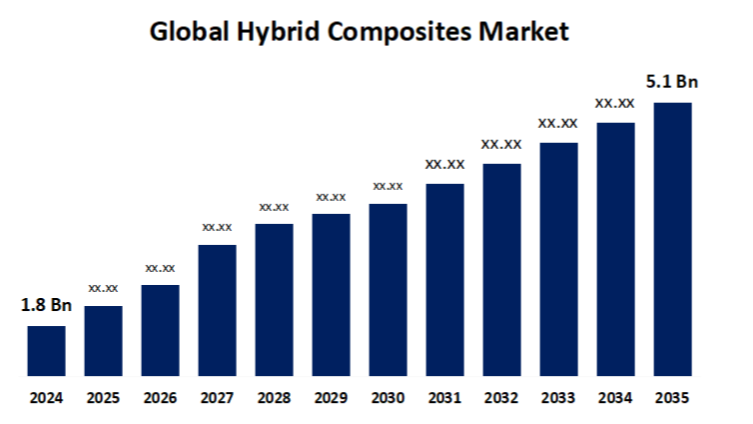Global Hybrid Composites Market Size To Exceed USD 5.1 Billion by 2035 | CAGR of 10.98%
Category: Chemicals & MaterialsGlobal Hybrid Composites Market Size To Exceed USD 5.1 Billion by 2035
According to a research report published by Spherical Insights & Consulting, The Global Hybrid Composites Market Size to grow from USD 1.8 billion in 2024 to USD 5.1 billion by 2035, at a Compound Annual Growth Rate (CAGR) of 10.98% during the forecast period.

Get more details on this report -
Browse key industry insights spread across 200 pages with 100 Market data tables and figures & charts from the report on the "Global Hybrid Composites Market Size Share, and COVID-19 Impact Analysis, by Fiber Type (Carbon/Glass, Carbon/Aramid), by Resin Type (Thermoplastic, Thermosetting), by End-Use Industry (Aerospace & Defense, Building & Construction, Automotive & Transportation), and By Region (North America, Europe, Asia-Pacific, Latin America, Middle East, and Africa), Analysis and Forecast 2025 - 2035" Get Detailed Report Description Here: https://www.sphericalinsights.com/reports/hybrid-composites-market
The hybrid composites market is experiencing significant growth, fueled by the rising demand for lightweight and high-strength materials across industries such as automotive, aerospace, wind energy, and construction. These composites, made by combining fibers like carbon, glass, or aramid, offer superior properties including enhanced mechanical strength, thermal stability, and resistance to corrosion. Their versatility and ability to be customized for specific applications make them well-suited for both structural and semi-structural uses. The automotive sector, in particular, is increasingly utilizing hybrid composites to comply with strict fuel efficiency and emission standards. Technological advancements in manufacturing processes like resin transfer molding and automated fiber placement are also supporting wider adoption. The Asia-Pacific region dominates the market, driven by rapid industrialization and government initiatives promoting sustainable, energy-efficient materials.
Hybrid Composites Market Value Chain Analysis
The hybrid composites market value chain comprises several critical stages, beginning with raw material suppliers who provide essential fibers such as carbon, glass, and aramid, along with resins like epoxy and polyester. These inputs are processed by composite manufacturers to produce hybrid fabrics or prepregs, combining various fibers to enhance performance characteristics. Component fabricators and part manufacturers then employ methods such as compression molding, vacuum infusion, and resin transfer molding to create tailored components for diverse applications. Distributors and suppliers ensure product quality and timely delivery throughout the supply network. End-use industries, including automotive, aerospace, wind energy, and construction drive demand based on specific performance requirements. Additionally, research institutions and technology providers contribute to innovation, sustainability, and process improvement. Seamless collaboration across the value chain is essential for cost efficiency and successful product development.
Hybrid Composites Market Opportunity Analysis
The hybrid composites market is poised for substantial growth, driven by changing industry demands and ongoing technological innovations. In the automotive and aerospace sectors, the need for lightweight, fuel-efficient materials is accelerating the use of hybrid composites. The renewable energy sector, particularly wind energy, is also a major contributor, as these materials support the production of longer, lighter, and more durable turbine blades. Asia-Pacific, with rapidly industrialising nations like India and China, is emerging as a key growth region, bolstered by favourable government policies. Additionally, advancements in biopolymer-based hybrids, thermoplastic matrices, and automated manufacturing processes are broadening the scope of applications. With growing emphasis on sustainability, performance, and cost-effectiveness, hybrid composites are set to gain wider acceptance across multiple end-use industries.
The hybrid composites market is witnessing robust growth, largely fueled by increasing demand in the automotive sector for lightweight, high-performance materials that improve fuel efficiency and reduce emissions. By combining two or more types of reinforcing fibres, hybrid composites deliver enhanced mechanical strength, durability, and design versatility, making them well-suited for both structural and interior automotive components. The aerospace and wind energy industries are also embracing these materials to meet high-performance requirements while minimising weight. Rising emphasis on sustainability and energy efficiency is further driving adoption across various sectors. Technological advancements in manufacturing and material innovation are supporting cost-effective production and broadening the range of applications. The Asia-Pacific region remains a key growth driver, backed by rapid industrialisation and supportive government initiatives.
A key challenge in the hybrid composites market is the high cost of raw materials, especially carbon and aramid fibers, which considerably increases overall production costs. The manufacturing processes are also complex, often requiring sophisticated equipment, skilled labor, and standardized procedures—factors that can be difficult for smaller or emerging companies to manage. Inconsistencies in material properties and the lack of standardization hinder quality control and product uniformity. Recycling remains a major obstacle due to the multi-material nature of hybrid composites, making sustainable disposal and reuse difficult. Additionally, limited awareness and slow adoption in certain end-use industries, coupled with stringent regulatory frameworks and economic uncertainties, continue to restrict market expansion and delay widespread implementation.
Insights by Fiber Type
The carbon/glass segment accounted for the largest market share over the forecast period 2025 to 2035. The carbon/glass fiber segment plays a pivotal role in driving the growth of the hybrid composites market, offering a well-balanced mix of strength, stiffness, and cost-effectiveness. This combination provides many of the performance benefits of carbon fiber at a more economical price, making it highly appealing across multiple industries. In the automotive sector, carbon/glass hybrids are increasingly utilized in lightweight and durable components such as body panels and structural elements. These materials are also gaining traction in aerospace, marine, and wind energy applications, where weight reduction and mechanical reliability are critical. As industries strive to improve performance while managing material costs, demand for carbon/glass fiber composites continues to grow. The segment is poised for sustained expansion, supported by broader application potential and ongoing technological progress.
Insights by Resin Type
The thermoset segment accounted for the largest market share over the forecast period 2025 to 2035. Thermoset resins are extensively utilized in hybrid composites for their excellent heat resistance and ability to retain structural integrity under stress. These characteristics make them well-suited for high-performance applications in sectors such as automotive, aerospace, and wind energy. In the automotive industry, thermoset-based hybrid composites are increasingly employed in structural components and electric vehicle battery enclosures due to their rigidity and thermal stability. Wind turbine blades also leverage thermoset composites for their lightweight and durable properties. Advancements in resin technologies including faster curing systems, bio-based alternatives, and improved compatibility with automated manufacturing are boosting production efficiency and sustainability. Consequently, thermoset resins continue to hold a leading position in driving hybrid composites market growth.
Insights by End Use
The automotive & transportation segment accounted for the largest market share over the forecast period 2025 to 2035. The industry's growing emphasis on lightweight, fuel-efficient, and eco-friendly solutions is driving the expansion of hybrid composites. Combinations such as carbon/glass fibers with thermoset resins are increasingly being used in structural components, interior parts, battery enclosures, and rail applications. The rise of electric vehicles is further boosting this trend, as reducing weight is critical to enhancing battery performance and overall energy efficiency. Beyond the automotive sector, the wider transportation industry, including railways, is also adopting hybrid composites for their excellent durability, corrosion resistance, and cost-effectiveness. With tightening emission regulations and a rising demand for high-performance materials, the use of hybrid composites in transportation is expected to grow steadily, fueled by ongoing technological advancements and deeper integration into modern mobility solutions.
Insights by Region

Get more details on this report -
North America is anticipated to dominate the Hybrid Composites Market from 2025 to 2035. The United States dominates the regional hybrid composites market, driven by its strong aerospace and defense industries, which are major adopters of advanced composite materials. Hybrid combinations like carbon/glass and carbon/aramid fibers are extensively used for their exceptional performance attributes. Thermoset resins continue to be the preferred matrix type in the region. The market benefits from the presence of leading manufacturers and OEMs, as well as supportive government policies that encourage the use of lightweight materials and clean energy solutions. While challenges such as high raw material costs and recycling limitations remain, continuous innovation and strong industrial demand reinforce North America's position as a key center for hybrid composite market growth.
Asia Pacific is witnessing the fastest market growth between 2025 to 2035. The automotive and aerospace sectors are major drivers of growth, as manufacturers increasingly adopt advanced composites to boost performance and comply with strict efficiency regulations. Wind energy is also a significant growth area, with hybrid composites playing a key role in producing lightweight, durable turbine blades. The region is further propelled by advancements in manufacturing technologies and a growing focus on sustainable, bio-based materials. Countries such as China, India, Japan, and South Korea are leading the charge, backed by robust domestic manufacturing capabilities and supportive government policies. As the demand for energy efficiency and sustainability intensifies, Asia-Pacific is rapidly emerging as a dominant force in the hybrid composites market.
Recent Market Developments
- In April 2022, Tenneco expanded its product portfolio and application scope in the automotive sector by introducing advanced OE hybrid friction material composites, engineered to meet the industry's rigorous standards for brake performance and driving comfort.
Major players in the market
- Royal DSM (the Netherlands)
- SGL Group – The Carbon Company (Germany)
- Gurit (Switzerland)
- Hexcel Corporation (US)
- TEIJIN LIMITED (Japan)
- Exel Group World Wide (Finland)
- Solvay (Belgium)
- PlastiComp, Inc. (US)
- Innegra Technologies, LLC (US)
- Quantum Composites (US)
Market Segmentation
This study forecasts revenue at global, regional, and country levels from 2025 to 2035.
Hybrid Composites Market, Fiber Type Analysis
- Carbon/Glass
- Carbon/Aramid
Hybrid Composites Market, Resin Type Analysis
- Thermoplastic
- Thermosetting
Hybrid Composites Market, End Use Analysis
- Aerospace & Defense
- Building & Construction
- Automotive & Transportation
Hybrid Composites Market, Regional Analysis
- North America
- US
- Canada
- Mexico
- Europe
- Germany
- Uk
- France
- Italy
- Spain
- Russia
- Rest of Europe
- Asia Pacific
- China
- Japan
- India
- South Korea
- Australia
- Rest of Asia Pacific
- South America
- Brazil
- Argentina
- Rest of South America
- Middle East & Africa
- UAE
- Saudi Arabia
- Qatar
- South Africa
- Rest of the Middle East & Africa
About the Spherical Insights & Consulting
Spherical Insights & Consulting is a market research and consulting firm which provides actionable market research study, quantitative forecasting and trends analysis provides forward-looking insight especially designed for decision makers and aids ROI.
Which is catering to different industry such as financial sectors, industrial sectors, government organizations, universities, non-profits and corporations. The company's mission is to work with businesses to achieve business objectives and maintain strategic improvements.
CONTACT US:
For More Information on Your Target Market, Please Contact Us Below:
Phone: +1 303 800 4326 (the U.S.)
Phone: +91 90289 24100 (APAC)
Email: inquiry@sphericalinsights.com, sales@sphericalinsights.com
Contact Us: https://www.sphericalinsights.com/contact-us
Need help to buy this report?